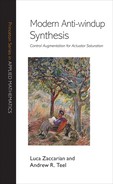When feedback control is synthesized for a linear plant, an often neglected but important feature of the feedback loop is a saturation nonlinearity at the plant input. A saturated input typically provides a better model of reality than a linear input model does. Indeed, all real actuators have limited capabilities and these limits can have a dramatic effect on the performance of an otherwise linear feedback loop. In the face of input saturation, the control engineer must accept that the achievable large signal performance is inherently limited. Then he or she must decide how to address this fact in control synthesis.
When input saturation is expected to be a common occurrence in the plant's operation, it makes sense to look for design methodologies that account for input saturation directly. There are many useful techniques in this category that have been developed in the control literature, including the very popular “model predictive control” framework. In the case where input saturation is expected to be a less frequent occurrence and the small signal performance specifications are difficult to incorporate into a general framework like model predictive control, it makes sense to consider the “anti-windup” paradigm.
In the anti-windup synthesis problem, a controller for the saturation-free case has already been synthesized based on some performance criterion and it has been confirmed that this controller does not perform well when input saturation occurs. In this case, the task is to synthesize a controller augmentation that has no effect when saturation does not occur and that otherwise attempts to provide satisfactory performance for large signals. In this way, the small signal performance is not compromised for the sake of guaranteeing acceptable large signal performance.
This book is dedicated to the description of anti-windup synthesis algorithms. The focus is on state-space methods and synthesis algorithms that require solving linear matrix inequalities (LMIs). Many efficient software programs, such as MAT-LAB/Simulink,1 are widely available for solving these LMIs. In order to follow the material in this book, the reader should be familiar with state-space descriptions and basic stability theory for linear, continuous-time systems. In order to become comfortable with the algorithms and their behaviors, the reader should be willing to invest the energy required to gain competency with an LMI solver. Several examples are provided in the text that can be used by the reader to test the understanding of the synthesis recipes and ability to reproduce numerically the anti-windup augmentation given in the examples. Throughout the book we emphasize algorithms over stability proofs, with the aim of making this book accessible both to industrial engineers and also graduate students and researchers interested in digesting the concepts associated with state-of-the-art anti-windup synthesis. Some advanced but still accessible ideas are provided in the text in sections marked with an asterisk. The reader may wish to skip these sections and can do so without breaking the continuity of the book's flow. Where the state of the art becomes too advanced to cover in this text, we provide references to work that can be found in the control literature.
In Part I of this book, we use examples to motivate anti-windup synthesis, we describe various anti-windup performance objectives, and we present the most common anti-windup architectures. In other words, we present the controller's structure without specifying the source of the controller's numerical values. In Part II, we provide various LMI-based anti-windup synthesis algorithms based on different large signal performance specifications. Some of these algorithms address global solutions, when possible. Otherwise, the focus is on algorithms that guarantee performance over a bounded region. We present algorithms that introduce no extra dynamic elements, in other words, “static anti-windup,” but the achievable performance with such augmentation is limited. When static anti-windup is not sufficient, we provide dynamic anti-windup algorithms. We also emphasize the nonlinear nature of performance in feedback loops with saturation and provide numerical algorithms for quantifying this nonlinear performance.
In Part III, we focus on a particular architecture and goal that we call “model recovery anti-windup” (MRAW). We start with linear synthesis algorithms that can be compared to the solutions given in Part II. However, a strength of the anti-windup approach in Part III is that it lends itself nicely to the synthesis of nonlinear anti-windup augmentation, exploiting ideas that have appeared in the nonlinear control literature over the last two decades. It also permits bringing the tools of model predictive control to bear on the anti-windup synthesis problem. Finally, we conclude the book with an extensive, annotated anti-windup synthesis bibliography.
We would like to express our thanks to all of our co-authors on the topic of anti-windup synthesis, and to other scholars who helped to shape our viewpoint on this problem through fruitful discussions, at conferences, and through email. We also thank the U.S. National Science Foundation, the Air Force Office of Scientific Research, the Italian MIUR, the ENEA-Euratom Association and the International Relations Office of the University of Rome, Tor Vergata, for their support of this research over many years. We express our appreciation to Petar Kokotovic, especially for his prodding to see this book through to its completion. Finally, we thank our families for enduring the absences that were required to finish this project.
| Rome, Italy Santa Barbara, California, USA Spring 2009 | Luca Zaccarian Andrew R. Teel |
1MATLAB® and Simulink® are registered trademarks of The MathWorks Inc. and are used with permission. The MathWorks does not warrant the accuracy of the text or exercises in this book. This book's use of MATLAB® and Simulink® does not constitute an endorsement or sponsorship by The MathWorks of a particular pedagogical approach or particular use of the MATLAB® and Simulink® software.
